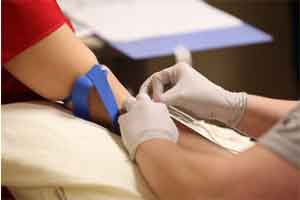- Home
- Editorial
- News
- Practice Guidelines
- Anesthesiology Guidelines
- Cancer Guidelines
- Cardiac Sciences Guidelines
- Critical Care Guidelines
- Dentistry Guidelines
- Dermatology Guidelines
- Diabetes and Endo Guidelines
- Diagnostics Guidelines
- ENT Guidelines
- Featured Practice Guidelines
- Gastroenterology Guidelines
- Geriatrics Guidelines
- Medicine Guidelines
- Nephrology Guidelines
- Neurosciences Guidelines
- Obs and Gynae Guidelines
- Ophthalmology Guidelines
- Orthopaedics Guidelines
- Paediatrics Guidelines
- Psychiatry Guidelines
- Pulmonology Guidelines
- Radiology Guidelines
- Surgery Guidelines
- Urology Guidelines
Increasing frequency of blood donation has no major side effects : BMJ

Giving blood more frequently -- up to every 8 weeks for men and every 12 weeks for women -- has no major side effects and could help to increase blood stocks, according to the first ever randomised trial of blood donation involving more than 45000 people in England published in The Lancet.
In the UK, men can donate every 12 weeks, and women every 16 weeks, but the study showed that reducing the interval between donations by 4 weeks (to every 8 weeks for men, and every 12 weeks for women) had no major impact on the donors' quality of life, mental function or physical activity, and increased the amount of blood collected over two years by 33% (1.7 units) in men and 24% (0.85 units) in women.
However, some people who gave blood more frequently did report minor symptoms including tiredness and restless legs, and the research suggests this may have been due to giving blood.
The findings may help overcome potential risks to blood stocks, including issues attracting and retaining young donors, and increased demand caused by aging populations. In addition, it could help to increase stocks of much-needed universal blood groups and rarer blood groups.
"This study suggests that more frequent blood donation is a feasible and safe option for donors in the UK, and gives blood services the short-term option of more frequent collection from donors if the supply falls or demand rises," says senior author Professor John Danesh, University of Cambridge, UK.
As well as the many thousands of people in the UK needing occasional blood transfusions, this could help people who need regular blood transfusions, such as people with sickle cell disease. Each year, tens of millions of people donate blood worldwide, resulting in 110 million donations which provide life-saving transfusions.
Senior author, Professor Dave Roberts, University of Oxford, UK, says: "In the future we can use our results to predict which donation intervals suit individual donors and move towards personalised donation intervals."
Lead author, Dr Emanuele Di Angelantonio, University of Cambridge, UK, says: "The study also showed that donors who weighed above average and those with higher initial stores of iron were able to give more blood."
Although blood donation services have been in place for more than a century, there has been no randomised trial to evaluate the most suitable interval between donations. This has led to varied blood donation policies globally with current practice in the UK allowing men to donate every 12 weeks and women every 16 weeks, while men and women can donate every 8 weeks in the USA, and in France and Germany men can donate every 8 weeks and women every 12 weeks.
The study involved 45042 blood donors (22357 men and 22685 women) aged 18 years or over from 25 centres in England. Men were split into three groups to give blood every 12, 10 or 8 weeks, and women gave blood every 16, 14 or 12 weeks. The trial took place over two years.
All participants completed online health questionnaires at the start and end of the trial, and at 6, 12 and 18 months to measure quality of life, symptoms related to blood donation (such as tiredness, breathlessness, feeling faint, dizziness, and restless legs), physical activity levels and cognitive function. They also gave blood samples at the start and end of the trial to measure haemoglobin and iron levels, and the researchers tracked instances where blood donations were postponed due to haemoglobin levels being too low.
Overall, men and women who gave blood most frequently donated 33% and 24% more blood than people who gave blood least frequently. Over 2 years, men and women in the most frequent donation groups gave 6.9 units and 4.3 units of blood on average each, compared to 5.2 and 3.4 units for men and women in the least frequent donation groups.
There was no difference in serious adverse events, quality of life, cognitive function or levels of physical activity between people who gave blood most and least frequently.
However, the researchers found that the reduced levels of haemoglobin and iron did not fully explain the increased rate of symptoms experienced by those giving blood most frequently, and propose that more research be done to better understand the causes of these symptoms.
The researchers note some limitations within the study, including that delays between measurements of symptoms associated with blood donation (questionnaires provided throughout the trial, asking about symptoms over the past six months) and haemoglobin and iron levels (measured at the end of the two year study) may explain why the association between iron deficiency and symptoms is weaker than expected.
For more details click on the link: DOI: 10.1016/S0140-6736(17)31928-1

Disclaimer: This site is primarily intended for healthcare professionals. Any content/information on this website does not replace the advice of medical and/or health professionals and should not be construed as medical/diagnostic advice/endorsement or prescription. Use of this site is subject to our terms of use, privacy policy, advertisement policy. © 2020 Minerva Medical Treatment Pvt Ltd